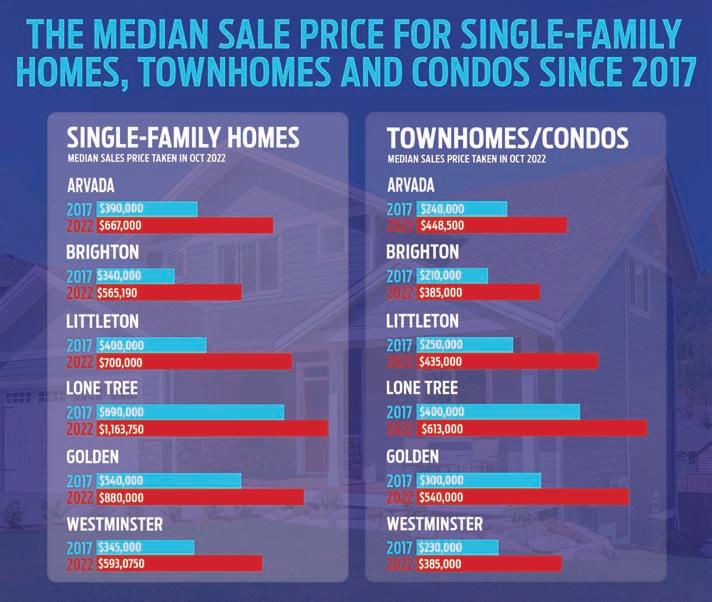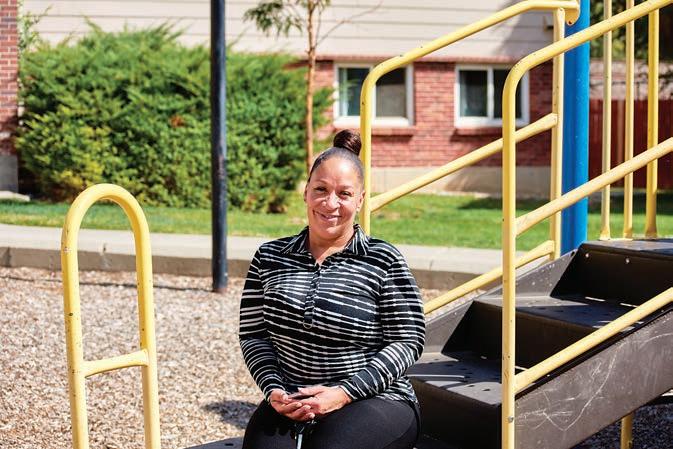
43 minute read
SPORTS
A new year, a clean slate
As we usher in 2023, we say “good riddance” to the market mayhem of 2022.
“A year to forget” is how one of our research partners dubbed 2022. Despite a modest rebound for many asset classes during the fourth quarter, 2022 turned out to be one of the worst years on record for multi-asset portfolios. ere were very few investment categories that posted positive returns for the full year. According to Ned Davis Research, it was the rst time on record that both the S&P 500 Index and the Bloomberg U.S. Aggregate Bond Index lost more than 10 percent in a calendar year. is means there was nowhere to hide. Both conservative and aggressive investors likely lost money. Some bond funds, normally considered the safer haven in a portfolio, were down double digits for the year as interest rates pushed higher. e good news is you might be earning a little more on your bond or money market yields.
Brett Lapierre, CFA cites stubbornly high in ation and aggressive rate hikes from most of the world’s central banks as two main reasons for the di cult year and weak performance across the nancial markets. e Russia/Ukraine con ict also added to the volatility, although it helped energy-related assets post positive results for the quarter and year. China shutting down for much of the year hurt exports and supply chains.
“ e U.S. economy showed more signs of slowing despite rebounding during the third quarter and likely seeing positive gains for the fourth quarter. e labor market remained one of the bright spots in the U.S. economy as the year ended, but the risk of a recession unfolding over the next 12 months remains elevated in my view,” says Lapierre.
During the fourth quarter, markets got a little reprieve with in ation data further improving and the Federal Reserve slowing down its rate hiking campaign. But the Fed has not quite nished raising rates yet. Nevertheless, interest rates were a little steadier during the fourth quarter than
earlier in the year with the 2-year U.S. Treasury yield nishing at 4.41%, up 19 basis points on the quarter, while the 10-year U.S. Treasury yield nished at 3.88%, up 5 basis points on the quarter. For the year, yields were up 363 basis points and FINANCIAL 225 basis points, respectively. STRATEGIES is is signi cant movement in the xed income world where many retirees are invested. Designing custom portfolios this year will be crucial for investors, especially if you were able to tax-loss harvest last year. You have a clean slate to begin a new strategy in a new year that ts with your nancial plan. Don’t wait to get in front of your advisor while the year is young. Patricia Kummer
Brett Lapierre, CFA, is Senior Investment Strategist for Mariner Wealth Advisors
Patricia Kummer has been a certi ed nancial planner professional and a duciary for over 35 years and is Managing Director for Mariner Wealth Advisors, an SEC Registered Investment Adviser.
ABOUT LETTERS TO THE EDITOR
Colorado Community Media welcomes letters to the editor. Please note the following rules: • Email your letter to letters@coloradocommunitymedia.com. Do not send via postal mail. Put the words “letter to the editor” in the email subject line. • Submit your letter by 5 p.m. on Wednesday in order to have it considered for publication in the following week’s newspaper. • Letters must be no longer than 400 words. • Letters should be exclusively submitted to Colorado Community Media and should not submitted to other outlets or previously posted on websites or social media. Submitted letters become the property of CCM and should not be republished elsewhere. • Letters advocating for a political candidate should focus on that candidate’s qualifi cations for o ce. We cannot publish letters that contain unverifi ed negative information about a candidate’s opponent. Letters advocating for or against a political candidate or ballot issue will not be published within 12 days of an election. • Publication of any given letter is at our discretion. Letters are published as space is available. • We will edit letters for clarity, grammar, punctuation and length and write headlines (titles) for letters at our discretion. • Please don’t send us more than one letter per month. First priority for publication will be given to writers who have not submitted letters to us recently. • Submit your letter in a Word document or in the body of an email. No PDFs or Google Docs, please. • Include your full name, address and phone number. We will publish only your name and city or town of residence, but all of the information requested is needed for us to verify you are who you say you are. • Letters will be considered only from people living in Colorado Community Media’s circulation area in Adams, Arapahoe, Clear Creek, Denver, Douglas, Elbert, Je erson and Weld counties. • Do not use all caps, italics or bold text. • Keep it polite: No name calling or “mudsling-
Our focus controls our balance
As a part of his workout, he included time standing on in atable balance discs in between sets of weightlifting. His goal was to maintain his balance on the disc for 45 seconds while standing on each leg. Sometimes he stayed in balance for more than 45 seconds, and other times he lost his balance quickly. As I watched his routine, I became curious. When we both nished our workout, I approached him to ask about his workout and goals for the balance disc. He shared with me that he was using the balance disc for several reasons. He wanted to make sure he was working on the little muscles around his ankles and knees. And he also felt like it improved his balance when walking, hiking, gol ng and skiing. en I asked him about why he was able to remain standing on one leg on the balance disc sometimes for a minute or more, and other times he lost his balance early or in just 10 or 15 seconds.
His response didn’t shock me. He shared that when he was able to maintain his focus on staying in balance on the disc, he could stay on for longer periods of time. He always stood in front of a mirror in the gym and would center his eyes on his chest in the re ection. e times when he achieved the greatest success were when he remained focused on his position. However, he said that when he lost his balance early it was because he allowed his mind to drift onto other things going on in his life.
How many of us lose our balance in life when we allow ourselves to become distracted? We all want balance, yet too often we wind up being our own worst enemy as we spread ourselves too thin. When we do this, we invite distraction into our lives, knocking us o balance and out of harmony. And when we nd ourselves feeling like we have lost it and balance is nowhere to be found, we should remember the lesson from my friend in the gym and reacquire our focus.
e rst thing we need to do is to understand our priorities and where we want balance and harmony in our lives. Once we are completely aware of what is truly important to us, then we can align our expectations and WINNING boundaries so that we don’t give way to the distractions that pop up. And most importantly, after establishing WORDS our priorities and setting our boundaries, is that we remain focused on the people, activities and things in life that bring us the greatest joy and satisfaction. Let’s face it, distractions come at us all day long, life happens. ey come in the form of calls, texts, emails, news, social media, unexpected circumstances and situations. We can never completely avoid being sidetracked, but we can minimize our chances of being distracted by knowing and owning our priorities and remaining focused on those. Michael Norton Michael Norton Not taking the time to think through and commit to what is most important to us is like trying to drive somewhere that we have never been without GPS or a map. And as the old quote by Lewis Carroll goes, “If you don’t know where you are going, any road will get you there.” Where are we missing our balance? Is it at home? At work? In our relationships? If we could improve the harmony in our lives, where would it create the greatest impact? For me, my balance comes when I remain focused on the ve Fs in life: my faith, family, friends, tness and nances, and in that order. And now thanks to my new friend from the gym, I can add the sixth F, focus. Are you nding balance in the most important areas of your life? Would a little more focus and less distractions help you nd your balance? I would love to hear your story at gotonorton@gmail.com and when we can maximize balance by minimizing distractions, it really will be a better than good life.
Michael Norton is an author, a personal and professional coach, consultant, trainer, encourager and motivator of individuals and businesses, working with organizations and associations across multiple industries.
FORT SERVING THE LUPTON COMMUNITY SINCE 1906
75c I
PRESS
A publication of
LINDA SHAPLEY
Publisher
lshapley@coloradocommunitymedia.com
MICHAEL DE YOANNA
Editor-in-Chief
michael@coloradocommunitymedia.com
SCOTT TAYLOR
Metro North Editor
STEVE SMITH
Sports Editor
ssmith@coloradocommunitymedia.com
LINDSAY NICOLETTI
Operations/ Circulation Manager
lnicoletti@coloradocommunitymedia.com
TERESA ALEXIS
Marketing Consultant Classifi ed Sales
Columnists & Guest Commentaries
Columnist opinions are not necessarily those of the Press. We welcome letters to the editor. Please include your full name, address and the best number to reach you by telephone.
Email letters to
staylor@coloradocommunitymedia.com
Deadline
Wed. for the following week’s paper.
Fort Lupton Press (USPS 205880)
A legal newspaper of general circulation in Ft. Lupton, Colorado, Fort Lupton Press is published weekly on Thursday by Colorado Community Media, 143 S. 2nd Pl., Brighton CO 80601. . PERIODICAL POSTAGE PAID AT Ft. Lupton and additional mailing o ces. POSTMASTER: Send address change to: Fort Lupton Press, 750 W. Hampden Ave., Suite 225, Englewood, CO 80110
The Long Way Home
Examining the impacts of the housing crisis
People across the metro area are struggling to a ord a place to live. Minimum wage earners might spend upwards of 60% of their paychecks on rent. Many millennials, now entering their 40s, have accumulated less wealth than prior generations and are struggling to nd a rst home they can a ord. At the same time, those who might sell, baby boomers, are prone to hold onto their homes, unable to downsize in the supercharged market. ese and other factors, including homelessness, a history of racial disparities where 71% of white Coloradans own homes but only 42% of Black Coloradans do, and a slow down in building that began more than a decade ago during the Great Recession, add up to constitute what some experts call a crisis in housing a ordability and availability.
Over the last six months, two dozen journalists, editors and sta at Colorado Community Media worked to answer questions on why this is happening, how we got here and what the solutions are. e work to nd the answers carried our journalists along the Front Range to talk to mayors, housing authorities, experts and, most importantly, lower- and middle-class families experiencing the crisis rst hand.
Our reporters and editors also held focus groups, talking directly to prospective homebuyers, like the single mom worried that another rent increase could land her in her car and the real estate agent who understood the problems but worried about a lack of solutions.
Over the next four weeks, Colorado Community Media provides an in-depth look at how the current crisis impacts our communities. In Week 1, e Long Way Home breaks down how we got here. On Week 4, we look at how local, state and federal governments are investing millions of dollars into a range of possible solutions – from helping the homeless to a ordable housing programs.

Contributors to theproject include:

TRICKLING UP
From work to school to neighborhood events, the program has created a way for Gilson’s family to be a part of a community. With housing and communities come resources, though not all are created equal. Gilson explained that in her prior communities — predominantly lower socioeconomic status and people of color — it resulted in a lack of resources, such as academic and mental health. at’s why she moved to Westminster, where she has lived for 12 years.
“I wanted my kids to have a stable education and stable housing,” she said.
It’s not just low-income residents who struggle to a ord housing. Across the metro area and along the Front Range, rising in ation and mortgage rates, a long-term building slowdown and increasingly crowded cities and towns have combined to create what some observers and experts say is a housing crisis.
More and more people throughout the metro area are nding the cost of renting or buying a home eating up signi cant portions of their budgets.
“ at’s the No. 1 reason that people move, is they can’t keep up with their rent (and) utilities payments,” said Heidi Aggeler, managing director and co-founder of Root Policy Research, a Denver-based community planning and housing research rm. ere’s a term for it: “cost-burdened,” which describes households paying more than 30% of their income on housing. A little more than 700,000 households in Colorado are cost-burdened, most of which are renters, according to a November 2021 report from Root Policy Research.
“We’ve never done a very good job of housing extremely low-income people and families and helping to move them out of poverty,” Aggeler said. “We’ve never had enough resources to adequately address that.”
People who make $25,000 or less a year have long faced a housing crisis on some level, Aggeler said. But now, the number of people who make more money and are feeling the pinch of high housing costs is growing.
It has become increasingly common for middle-income households with incomes of roughly $35,000-$75,000 to experience cost burden, according to Root Policy Research.
As long as Colorado continues to be an attractive place for people to move to, invest in and retire, Aggeler thinks housing challenges will continue. ere are also too few options for would-be buyers. Many nd the cost of single-family homes beyond their reach but have few options a step below that, such as condos.
“If you believe that Colorado will be a place that employers will continue to want to move to, then I think … the outlook may not be good unless we accelerate production and density and fund housing at the level that is needed,” Aggeler said.
The cost of housing
Practically every community in the metro area is facing its own housing a ordability and availability issues. South of Denver, in Lone Tree, Mayor Jackie Millet said there is a “housing crisis.”
“I think it varies in severity throughout our state, but I do think it is a problem that is a ecting all of Colorado,” she said. “ ere’s so much supply pressure on our market right now that we have, then, created this crisis.”
Not everyone is describing it as a crisis, but those who use that word point to the numbers across the metro area, as the costs of singlefamily homes and townhomes have skyrocketed.
Northwest of Denver, in Arvada, the median sale price of a singlefamily home was $667,000 as of late 2022, according to the Colorado Association of Realtors. at’s up by 71% from 2017, when the price was around $390,000. e story is similar in Brighton, northeast of Denver, where the median sale price increased by approximately $225,000 over that period.
Littleton, south of Denver, saw an increase of approximately $300,000 in the price of single-family homes from 2017 to 2022.
Lone Tree saw an increase of $473,750.
“What we have seen is our housing prices doubling and our wages have not been keeping up,” Millet said.
From 2000 to 2019, median rents rose at a faster rate than median renter household incomes did “in every Colorado county and city with 50,000+ residents,” according to Root Policy Research.
Many residents want a home of their own, Millet said.
“ at was our ultimate goal, and that is also the way most of us accumulated wealth,” she said.
When the cost of buying or renting is too high, however, people cannot establish these roots, she added.
Supply versus demand
One of the main causes of the rise in cost-burdened households and lack of a ordable housing is that production has failed to keep up with demand. ere was a 40% decrease in the number of homes built between 2010 and 2020 in Colorado, according to the 2022 “A ordable Housing Transformational Task Force Report.”
Susan Daggett, executive director of the Rocky Mountain Land
Use Institute, said the crash of 2007 a ected housing supply. People left the construction industry and many companies went bankrupt.
“ e housing market bottomed out, people left the construction industry, a lot of people went bankrupt,” she said.
At the same time that housing development slowed, Colorado’s population grew.
“In the meantime, the population has grown tremendously and the supply just hasn’t been able to catch up with that demand,” Daggett said.
In 2010, Colorado had a population of 5,029,196, according to the U.S. Census Bureau. By 2022, the population was estimated at 5,839,926 — a roughly 16% increase.
As of June 2021, Colorado’s for-sale housing inventory was 13% of what is needed for a functioning sales market, according to Root Policy Research’s report. A functioning sales market means there are enough units so that people can move easily, such as being able to upsize or downsize, Aggeler said.
To return the housing market to a functioning level, Colorado would need an average of 44,250 units built each year until 2030, according to the report, published in November 2021. is would be 1.6 times the state’s current production levels.
Ted Leighty — the CEO of the Colorado Association of Home Builders, an a liate organization of the National Association of Home Builders — said, overall, depending on who is talking, Colorado is somewhere between 175,000 to 200,000 units short of demand.
“ at’s really challenging to come back from, especially, you know, the pace by which we were able to produce new housing in Colorado,” Leighty said.
He hates to use the word “crisis” when discussing housing in Colorado, describing it instead as a major challenge.
Leighty explained the challenge comes down to the ve L’s — lumber and other building materials, labor, land, loans and access to capital, and local government. All have played roles in slowing down housing construction, especially since the Great Recession, leading to higher demand and decreased a ordability.
“ ese are always our main cost drivers for residential construction,” Leighty said. “All ve of those right now, and have been, unfortunately, for the last several years, been huge challenges for us.”
He said high lumber costs and some supply chain issues have improved marginally recently, but they still pose problems for developers.
Also, there is a labor shortage.
“We’ve seen a little bit of uptick in (the) labor participation rate for construction, but not nearly enough,” Leighty said. “We’ve got an aging skilled labor demographic, and we haven’t done a great job replacing that labor with younger, skilled laborers.”
In addition to training the laborers of the next generation, Leighty said a “sound immigration policy” could help bring more workers to projects.
“ ere’s a pretty big de cit, and we need to do all we can, policy standpoint and otherwise, to increase labor,” Leighty said.
During the pandemic, there was a perception the housing market was hot, Leighty said.
“It was the most challenging hot market ever on record — to source materials, to source labor, to get projects through the pipeline was immeasurable in how di cult it was,” Leighty said.
The market cools
But there are signs the hot market is cooling.
Lending issues have recently risen to the top of many homebuyers’ concerns. Leighty cites concerns for in ation, economic uncertainty and rising interest mortgage rates.
Imagine a $500,000 home that roughly a year ago a person could buy at a 3% rate, Leighty said. eir monthly payment might be around $2,600.
By July 2022, as rates rose to roughly 5%, the payment for the same house would rise to $3,500. at’s an increase of more than 34%.
“So, how do you get back down to that $2,600, you know, something that’s more achievable for the average home buyer?” Leighty asked rhetorically.
In December, rates on a 30-year xed mortgage were more than 6.5%, according to Bankrate.
Higher mortgage rates caused a spike in cancellation rates for home-sale contracts last summer, reaching above 40% — causing further disruptions, Leighty said.
“By the time the home was ready, or maybe even wasn’t ready yet, they knew what their debt-to-income ratio was going to be and that it had increased immensely, and they could no longer a ord it, so they canceled,” he said.
By comparison, the cancellation rate was 13% in July 2021 and 18% in 2019.
Due to these high cancellation rates, it is likely there will be fewer homes on the market in the next few quarters, Leighty said, further exacerbating housing issues.
Yet Matthew Leprino, a spokesperson for the Colorado Association of Realtors, explained there’s an upshot for some potential homebuyers. ere are more homes available now than in years past as the market reacts to the changing economy.
“ e story that I’ve been telling a lot of clients lately is, ‘Yeah, you can pay a higher interest rate now than you were a year ago, but you’re paying $100,000 less for the house,’” he said. ere are more properties available now than any time since October of 2019, he said.
“It’s a better time to buy now than in the last three years,” Leprino said.
A balanced market’s months’ supply of inventory stands at about four months. For the metro area, October 2022 was the rst time that number hit two months or above since October 2019. e metro Denver area hasn’t reached a balanced market for housing since at least 2014, when the Colorado Association of Realtors started tracking that data — and Leprino suspects it’s been much longer than that.
“Number one, houses are a lot more expensive than they used to be,” Leprino said. “Number two, there’s not enough of them.”
The role of local governments and zoning
Local governments have played a huge role in the lack of housing supply and lack of a ordability in Colorado, Leighty said.
He notes they play a role through their regulations, land use zoning and entitlement process and their fees.
Zoning can be a signi cant factor in the housing issues people see today, Aggeler of Root Policy Research said. It refers to when a city or county divides its land into di erent sections and designates an intended use for each, such as industrial or residential development.
“Really, the problem, it’s very simple: ere’s a scarcity of housing for people of all income levels,” said Pat Cronenberger, vice chairperson for South Metro Housing Options, the City of Littleton’s public housing authority. “Colorado is a popular place. People want to be here, and we have restrictive zoning laws that really don’t make it easy to build housing.”
“And that’s all contributed to high rents and big, skyrocketing home prices,” she said.
One of the more controversial zoning issues across the metro area is how dense a city can build.
“People are very afraid of adding units, very afraid of density — and I think probably overly so,” Aggeler said. “We should be zoning artfully, in a way that preserves what we love about communities but also provides opportunity for other people to live there.”
Leighty said some local elected of cials have expressed concerns that if they approve denser housing units, they could be recalled “because there’s so many people that believe we have — we’re growing too fast.”
“But the numbers belie all of that,” he said. “Our net migration is still positive.”
Net migration refers to the di erence between the number of immigrants and the number of emigrants throughout the year.
“ at’s how you’re going to attack this issue, right, is allowing greater density — taking down the land costs a little bit by being able to do more with less as far as more construction on less land,” Leighty said. “Zoning plays a huge role in our ability to bring new product on the market.”
A lot of communities in Colorado are mostly single-family homes, resulting in lower density and forcing developments to sprawl out.
With the dominance of single-family homes, many communities in Colorado face a “missing middle,” meaning there are not a lot of diverse housing options such as townhomes, cottage courts, accessory dwelling units and duplexes.
Part of the reason for that is because of a policy change, Leighty said.
“We made it really, really easy to sue for what they call ‘construction defects’ on multifamily for-sale condominiums,” he said.
Multifamily for-sale condominiums went from roughly 20% of the market to about 2% of the market when going into the recession, Leighty said. By 2017, it rose to about 12% of the market, but then the pandemic hit.
“If you kept that 20% pace of condominiums, you wouldn’t be in the same situation you are now. You wouldn’t necessarily be in market equilibrium, right? But you wouldn’t be … 200,000 units shy either,” Leighty said.
Condominiums are a really important product, he said, as they provide places for young professionals and families to achieve homeownership and for empty nesters to downsize.
“ at product has been absolutely missed in this marketplace and it has certainly contributed to our inability to keep up with demand,” Leighty said.
Lone Tree Mayor Jackie Millet said in 2004, she served on the city’s planning commission and approximately 20% of the new buildings were condos.
“To my recollection, in Lone Tree, we haven’t seen one in probably 15 years. And the ones that are being built in the metro region are either — they’re very, very expensive,” she said. “ at was our supply of entry-level housing, and it is no longer being produced.”
Millet thinks the constructiondefects law played a signi cant role in the supply of the entry-level housing market. She also knows of residents who wish to remain in the community and want to downsize, but cannot nd any a ordable options.
Typically, Millet believes the markets should resolve the issues themselves.
“But in my opinion, the markets have been corrupted by a number of things,” Millet said. “And so I do feel at this point, we must do something other than just complain about it, because we’ve seen it increase as a priority issue for our residents and our businesses.”
“If we just keep complaining about it, which is what we’ve been doing, without taking any kind of action to increase the supply of housing that people can a ord, the problem is just going to get worse.”



The perfect storm: Many factors lead to today’s housing crisis

BY DEB HURLEY BROBST DBROBST@COLORADOCOMMUNITYMEDIA.COM

Kim Howard of Evergreen has been in her 2,600-square-foot home for 40 years. Now alone, the 70-year-old is looking to downsize and move closer to Denver, but she can’t nd a smaller home with the same or lower mortgage payments.
She feels guilty staying because she knows the house is a perfect size for a young family, but she’s staying because she can’t a ord to move. Rising interest rates in the last year aren’t helping, since that increases monthly payments on any home she could buy.
“I’m going to wait it out … because it has to make economic sense,” Howard said. “I can’t a ord to move, and that puts a damper on those who want to move in. We need more a ordable housing for retired and rst-time buyers instead of large, expensive homes that we can’t a ord.
“I feel kind of guilty. (Young families) are desperately looking to start their lives, and we senior citizens can’t a ord to move. Unless someone provides for those rst-time home buyers and for seniors who want to downsize, it’s not going to happen.”
Howard’s story is typical of the issues faced by many in the metro area when it comes to housing. While it seems like the crisis came on suddenly, it cannot be attributed to one moment or incident. Instead, think of it like the spokes on a bicycle wheel, with the center being the current housing situation.
Each spoke contributes to rising costs and shrinking availability, starting with the Great Recession that began in 2007, the loss of builders and labor, the dichotomy of home ownership between baby boomers and millennials, and more recently the pandemic, the consequences of the Marshall Fire and the popularity of short-term rentals.
Couple all that with population increasing in metro Denver, and it’s a recipe for disaster for many: higher home prices, increasing number of unhoused, lack of places to both buy or rent, frustrated home buyers and more.
A perfect storm has combined to create what many experts say constitutes a housing crisis throughout the Denver area and into the foothills — from Brighton to Empire and everywhere in between. It’s been brewing since the Great Recession more than a decade ago that created a harsh economic downturn, pushing skilled workers who built homes out of their careers.
It’s been exacerbated by a rising younger population and part-time residents who converted residences in some of the state’s most attractive settings into vacation homes, the skyrocketing costs of homes and increases in interest rates.
“ ere’s no incentive in the traditional market structure that we have around housing to build for those who are struggling economically,” said Phyllis Resnick, executive director and lead economist for the Colorado Futures Center, an independent, nonpartisan, academic nonpro t. “We think (the housing market) is feeling unhealthy for folks because housing that is a ordable to lower-middle to low-income households is still very di cult to nd and isn’t probably being built at the rate it’s needed.”

Great Recession
e metro area’s housing challenges start with the Great Recession that began in late 2007, part of a national trend where the housing market crashed. Before the recession, rising home prices, loose lending practices and low interest rates were the norm. When the economy soured, many homeowners could not keep up with their payments, prompting a rash of foreclosures.
According to real estate data company RealtyTrac, 6.3 million homes went through foreclosure in the United States from January 2006 to April 2016, more than double the norm of around 250,000 foreclosures per year. According to the Colorado Department of Local A airs, from 2006 to 2016, Colorado saw 299,775 foreclosures.
With foreclosures came a glut of available homes that ooded the market, according to real estate agent Gaye Ribble with e Ribble Group, a real estate rm that o ers home-buying services across the metro area. In the Denver metro area at the peak of the recession, 45,000 homes were on the market, Ribble said, when a balanced market is roughly 10,000 to 12,000 homes.
“As a result, builders were reluctant to get back in and buy land, buy materials, pay wages and build — all the capital expenses they incur before selling a single home,” said Tupper Briggs with Madison & Co. Properties, a real estate agent for more than four decades. “ ey did not add to the supply of housing for years.”
In other words, Ribble said, “builders stopped building homes because of the glut, and some builders went out of business because of the lack of work.”

Shelley Gilson smiles at the playground at Orchard Crossing in Westminster on
Sept. 27, 2022. PHOTO BY ANDREW FRAIELI
out what Ribble noticed. A 2018 study by Resnick and Jennifer Newcomer, research director, examined the factors contributing to the growing cost of housing in Colorado. Much of it could be traced to the Great Recession. e decrease in units built after the recession was linked, in part, to limited amounts of developable land, rising material costs and little incentive to build entry-level housing, according to the study. A bigger issue turned out to be the closure of several local construction companies and the related issue of a shortage of labor in specialty trades.
“Labor was short, it was a mixed story on materials, and there were some regulatory barriers, but I think we came away thinking that part of the biggest problem was we lost a lot of people in the development and building ecosystem,” Resnick said.
According to a 2014 report published by the U.S. Bureau of Labor Statistics, “Housing: Before, During and After the Great Recession,” construction industries experienced signi cant job losses during the recession.
From 2003 to 2013, for example, the residential construction industry experienced a 26.8% decrease in employment, which the report said was “precipitated by the recent recession.” e report also showed from 2003 to 2013, the number of businesses in the residential construction industry decreased by 10.8%.
Lone Tree Mayor Jackie Millet said she thinks the recession absolutely impacted the growth of housing.
“ e bottom fell out of the market, the tradespeople — we lost people in the trades, we didn’t have people coming into the trades, and we lost that time,” Millet said. “And it’s, you know, cyclical, so we have been playing catch-up ever since then.”
Ted Leighty, the CEO of the Colorado Association of Home Builders, said the Great Recession made a lot of people more cautious, including banks, lenders and builders. ere were fewer land developers coming out of the recession, he said, so more builders have had to become their own land developers.
“ eir access to capital and their cost of capital has increased greatly since the recession,” Leighty said.
Ribble added: “Not only every year are we lagging (in home construction), but we were never able to make up for six years with no new construction. During that time, population continued to increase.”
Population growth, interest rates
According to the U.S. Census Bureau, the seven-county metro area has seen a substantial rise in population in roughly the past decade. Douglas, Arapahoe and Adams counties each grew by more than 80,000 people, with Je erson County gaining more than 45,000 people.
When the Federal Reserve lowered interest rates to move the United States out of the Great Recession, many more people who wanted to buy a home could. Rates remained low as the economy rebounded. at increased demand across the housing market. As demand rose, prices across the metro area began to skyrocket, creating a crunch. Fewer homes were available and many people were simply priced out of the market.
Real estate agents interviewed by Colorado Community Media agree that the Federal Reserve should have increased the ultra-low interest rates to keep the market more balanced.
Baby boomers, millennials and shortterm rentals
Adding to the housing challenges is stagnation. Baby boomers, those nearing retirement age and older, aren’t leaving their homes. Meanwhile millennials, some now new to Colorado and in their 40s, are looking to get into their first home and sometimes even a second home such as a short-term rental that can be used for both vacation and added income..
Boomers, many of whom are empty nesters, aren’t downsizing for many reasons. While some simply don’t want to move, others want to downsize but can’t nd a good deal on a home in the community they want.
According to Jackie White, a real estate agent in the Conifer and Evergreen area for nine years, if a baby boomer sells a home for $1.5 million, that person isn’t going to nd a home about half the size for $750,000.
“That doesn’t feel good to them,” White said. “Add to that, because of low inventory of homes, kids can’t afford to buy homes in the communities they grew up in, so there are fewer multigenerational families in one community. Kids can’t easily check in on their parents.”
Many millennials can’t a ord homes that are for sale. at eventually will
Low Rate of Pay:
How minimum wages are failing to keep pace with housing costs


BY ANDREW FRAIELI AFRAIELI@COLORADOCOMMUNITYMEDIA.COM

In recent years, minimum wages have slowly increased, with Denver reaching $17.29 an hour, and the suburbs surrounding the city being lower, based on the state of Colorado’s minimum of $13.65 an hour.
While workers have welcomed the increases, apartment rental prices have outpaced those gains for workers, with almost 60% of a minimum wage worker’s paycheck expected to go to a landlord. at’s the highest proportion in a decade, and a calculation that doesn’t include other expenses, such as utilities.
“We’ve seen over the years that the minimum wage actually erodes over time, and periodically has to be readjusted,” said economist Markus Schneider.
Schneider, chair of the Economics Department at the University of Denver, said these cost-of-living adjustments to the minimum wage do help workers — both Denver and the state make adjustments to their minimum wages — but despite increases, the adjustments don’t completely stave o the consequences of rising in ation and skyrocketing housing costs on low-income workers.
Even after a decade, workers are still forced to dedicate too much of their salaries to housing, and it’s only worsened.
A “living wage” is what is needed to keep up with the costs of living, the “very ne line between the nancial independence of the working poor and the need to seek out public assistance or su er consistent and severe housing and food insecurity,” according to MIT’s Living Wage calculator. MIT describes it “as a minimum subsistence wage.”
For the metro area, that living wage is $19.62, well above the state minimum wage and even Denver’s. e cost-of-living adjustment that both minimum wage rates are tied to is called the Consumer Price Index — a “positive step in the right direction,” according to Schneider.
“At the same time, the minimum wage is below a living wage,” Schneider said. “It’s, at best, going to keep it in proportion.” at means the disparities won’t grow as badly as they could, but will still not keep up with a living wage.
In 2010, the state minimum wage was $7.24 an hour. Rent for a studio in the metro area was $638, according to U.S. Housing and Urban Development fair market rent data. at came out to half of a worker’s wages, which the National Low Income Housing Coalition — a nonpro t that aims to end the a ordable housing crisis through policy and data research — deems una ordable, as is anything upwards of 30% of wages spent on rent and utilities. e coalition considers paying upwards of 30% as placing workers at risk for homelessness.
By 2023, the situation had only grown worse for minimum-wage workers. While their wages rose to $13.65 an hour, metro-area studio apartment rents hit $1,390, meaning workers have to pay almost 60% of their wages to keep a roof over their head.
Part of the gap between the index increases and rent is inequality, Schneider said.
CPI is calculated by looking at how much change there is in the average price of household items, food, energy, rent, electronics and more, weighted by how big that category is in the household budget. is calculation is for the entire metro area, though. With di erent parts having di erent wages and costs of rent, the CPI can become skewed for some.
“ e CPI for Colorado is going to be very responsive to what’s happening in Denver just because that’s the big population center,” Schneider said. “We know that Denver has actually had a hotter housing market, and housing is a big component of what that living wage means.”
However, higher minimum wages do not cause rents to increase, in his view.
“ ere’s really not much evidence for it — in the ranges that we’re talking about raising minimum wages,” he said. “If we raised it by a factor of two, or even of ve, then yes, that’s probably a big thing. But we’re talking about just getting closer to a living wage — I’m very skeptical that it’s a big e ect.”
“Certainly not a big impact on the price aspect, because even when people get up to that living wage, it’s really only going to impact relatively cheap housing, and relatively bottom end of the rent market — you’ll see some of those rents go up a little bit. But the average rent in Denver isn’t going to budge much.” is leads to CPI not adjusting enough for the lowest wage earners in the metro area, and not keeping up with their rising rents. As Schneider said, the adjustments are better than nothing, but still do not set minimum-wage workers to earn a living wage — a goal that, since more than a decade ago, has only become further away.
“When people make more money, particularly at the bottom end, when we’re talking about pushing poverty line or at least well below the living wage, they’re likely to move to a nicer neighborhood or closer to a nicer school, which means the rents in the places that they were living won’t be a ected that much,” Schneider said.
According to MIT, a “livable wage” for Colorado is about $19.16 an hour, and the Denver-Aurora-Lakewood metro area “livable wage” is even higher at $19.62 per hour. Current minimum wage in the state is far less at $13.65 an hour, with Denver’s being $17.29 per hour. Both the state and Denver may be increasing minimum wage year over year to follow in ation or cost of living, but they may never actually reach a “livable wage” when they are already so far behind.
Colorado state’s minimum wage, and Denver’s own minimum wage, rise incrementally based on the Consumer Price Index (CPI). is is functionally a measurement of the cost of living, measured by the U.S Bureau of Labor Statistics. It includes food, housing costs, transport, medical care and recreation among others, all broken down to smaller parts like gas, and electric bills. MIT’s “living wage” considers many of the same categories, but is stricter.
“ e living wage is the minimum income standard that, if met, draws a very ne line between the nancial independence of the working poor and the need to seek out public assistance or su er consistent and severe housing and food insecurity,” according to MIT’s Living Wage calculator. “In light of this fact, the living wage is perhaps better de ned as a minimum subsistence wage for persons living in the United States.” eir calculator uses Fair Market Rents (FMRs) — which “represents the cost to rent a moderately-priced dwelling unit in the local housing market” — along with local utility prices, to determine housing costs.
According to e National Low Income Housing Coalition (NLIHC), a nonpro t that aims to end the a ordable housing crisis through policy and data research, anything upwards of “the generally accepted standard of spending no more than 30% of gross income on rent and utilities,” is considered una ordable housing, though. is brings needed wages, according to NLIHC, even higher than MIT’s livable wage that already lies on the razor’s edge of nancial independence and public assistance.
Other major costs in MIT’s calculation are food and transportation, which take up another $9,160 per year — $4,153 and $5,007 respectively. Housing, food and transport together take up 75% of their salary — which leaves some room for the $4,814 cost for “clothing, personal care items, and housekeeping supplies,” and $2,768 for medical care, but none for the $7,929 in annual taxes.
MIT speci es that the calculation “accounts only for the basic needs of a family. It does not account for what many consider the basic necessities enjoyed by many Americans,” such as dining out and other forms of entertainment, but it also “... does not provide a nancial means for planning for the future through savings and investment or for the purchase of capital assets.”
And this is all for single adults without children. A single adult with one child brings the livable wage from $20.61 an hour to $39.96.
NLIHC’s “Out of Reach” reports use “housing wage” as the wage a full-time worker must make to a ord FMRs without spending over 30% on rent. For a studio apartment in Denver with an FMR in 2022 of $1,236 per month, the “housing wage” would be $23.77 an hour before taxes — 1.5times what a minimumwage worker currently makes. is is even higher than MIT’s $20.61 an hour “livable wage” for a studio apartment and even includes utilities, as MIT’s wage is only enough to be on the brink of nancial ruin.
Based on NLIHC’s metric, no housing in Denver is actually “affordable” to a minimum-wage worker. It may never reach this point either.
Denver’s 2020 minimum-wage ordinance began with increasing minimum wage to $12.85 per hour in January 2020, then $14.77 in January 2021, then $15.87 in January 2022, and $17.29 this year.
From now onward, it’s tied to CPI. According to the ordinance, “the Denver minimum wage rate shall increase by an amount corresponding to the prior year’s increase, if any, in the Consumer Price Index …” But this wage is already below the “living wage” determined by MIT, so staying on par with the CPI will only ever keep the minimum wage stable, not increase its value.

With voter approval, the state will embark on how to have more a ordable housing statewide. SHUTTERSTOCK IMAGE

Thu 1/19
Featured



Professional Rodeo @ 1:30pm Denver Coliseum, 4600 Humboldt St., Denver
Featured



Money Matters: It’s your dough, make it stretch @ 5:30pm Anythink Huron Street, 9417 Huron Street, Thornton. swhitelonis@any thinklibraries.org, 303-452-7534 Birthday Celebration (Jan)

@ 8pm Eagle Pointe Recreation Center, 6060 E. Parkway Dr., Commerce City. 303-2893760
Candlelight Dinner Theatre/Motones & Jerseys

@ 11:45pm Fort Lupton Recreation & Parks De‐partment, 203 S Harrison, Fort Lupton. 303-857-4200

Breakfast Burrito Bingo 1/20
@ 4pm Bison Ridge Recreation Center, 13905 E. 112th Avenue, Commerce City. 303-2893760
Featured




Cowboy Dave: National Western Stock Show rodeo after party @ 9:30pm Denver Coliseum, 4600 Humboldt St, Denver
Sat 1/21
Climbing Crew
@ 12am Jan 21st - Jan 20th Bison Ridge Recreation Center, 13905 E. 112th Avenue, Commerce City. 303-2893760
Featured

All Levels Bird Walk @ 8am Standley Lake Regional Park & Wildlife Refuge, 11610 West 100th Avenue, Westminster. standley lake@cityofwestminster.us, 303425-1097
Teens: Slick City
@ 6:45pm Fort Lupton Community / Recreation Cen‐ter, 203 S. Harrison Avenue, Fort Lupton. 303-857-4200
Featured

Eric Golden @ 7pm Vfw Post 7945, 10217 Quivas St, Thornton
Sun 1/22
World of Beers Series 21+
@ 2am Jan 22nd - Jan 21st Offsite, 6060 E Parkway Drive, Commerce City. 303-289-3760
Featured Featured

Denver Nuggets vs. Oklahoma City Thunder @ 6pm / $12-$2540 Ball Arena, 1000 Chopper Circle, Denver
Drums of the World (1/22)
@ 8:30pm Eagle Pointe Recreation Center, 6060 E. Parkway Dr., Commerce City. 303-2893760
Mon 1/23
Featured

Sled dog talk with Chloe, Nog‐gin and their musher Karen @ 2pm Anythink Brighton, 327 East Bridge Street, Brighton. rbowman @anythinklibraries.org, 303-4053230
100 Things to Do Before You're 12
@ 5pm Bison Ridge Recreation Center, 13905 E. 112th Avenue, Commerce City. 303-2893760
National Pie Day
@ 10pm Eagle Pointe Recreation Center, 6060 E. Parkway Dr., Commerce City. 303-2893760
Tue 1/24
New Year, Get in Gear!
@ 1am Jan 24th - Apr 12th Bison Ridge Recreation Center, 13905 E. 112th Avenue, Commerce City. 303-2893760
Colorado History Center (1/24)
@ 4pm Eagle Pointe Recreation Center, 6060 E. Parkway Dr., Commerce City. 303-2893760
powered by
Tuesday Movie Matinee at Eagle Pointe 1/24
@ 8pm Eagle Pointe Recreation Center, 6060 E. Parkway Dr., Commerce City. 303-2893760
Wed 1/25
Fitness for the Family
@ 1:30am Jan 25th - Mar 7th Eagle Pointe Recreation Center, 6060 E. Parkway Dr., Commerce City. 303-2893760
Coffee with Charity Clifton from Oak Street Health (1/25)
@ 4pm Eagle Pointe Recreation Center, 6060 E. Parkway Dr., Commerce City. 303-2893760
Thu 1/26
Jenny Shawhan
@ 4pm Harry's at Magnolia Hotel Denver, 818 17th St, Denver
Featured

Full Cord w/ Elle Michelles Grateful Holler "Live on the Lanes" at 100 Nickel (Broom�eld) @ 7pm 100 Nickel, 100 Nickel St, Broom‐�eld
Featured

Colorado Avalanche vs. Anaheim Ducks @ 7pm / $49-$999 Ball Arena, 1000 Chopper Circle, Denver


Solution
© 2016 King Features Synd., Inc.


TRIVIA
1. GEOGRAPHY: What is the second-longest river in North America? 2. MOVIES: Which 1973 movie advertised itself as a place “where nothing can possibly go wrong”? 3. GAMES: Which party game claims that it can “tie you up in knots”? 4. U.S. PRESIDENTS: Which president was the rst to appoint an African American as a member of his Cabinet? 5. HISTORY: When was the Warsaw Pact between the Soviet Union and seven Eastern Bloc countries signed? 6. TELEVISION: Which TV game show often uses the phrase “Survey says ...”? 7. ANIMAL KINGDOM: What is a female peacock called? 8. FOOD & DRINK: How many meals do Hobbits eat in a day,
according to the movies? 9. ADVERTISING: Which product used a manicurist named Madge in its advertisements? 10. MEDICAL: What is a common name for the condition called septicemia?
Answers
1. e Mississippi. 2. “Westworld.” 3. Twister. 4. Lyndon Johnson. 5. 1955. 6. “Family Feud.” 7. A peahen. 8. Seven. 9. Palmolive dishwashing liquid. 10. Blood poisoning. (c) 2023 King Features Synd., Inc. Crossword Solution





